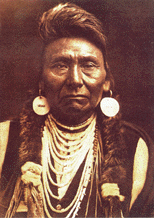American History
Retold

From the published works of Native Americans a different kind of American history emerged. It was a history of the conquered and it told of fallen heroes, villainous white men, and frequently of broken promises. In "Indian Heroes and Great Chieftains," Ohiyesa[Charles Eastman] redeemed
Native American warriors like Sitting Bull from white writers who
presumed to defile his reputation. In essays like "Three noted Chiefs of the Sioux" published by Harper'sin 1890 Sitting Bull was defined as
a "famous chief of mediocre ability, not noted for bravery as a
warrior, and inferior as a commander, and an intelligence to some of
his lieutenants(Anon, p1). The author goes on to explain Sitting
Bull's influence on his people as the result of "sheer obstinacy,
stubborn tenacity of purpose." Writers like Ohiyesa used their
writing as a place to combat these negative stereotypes and to
redeem their heroes from the dustbin of the whiteman's history.
Native American leaders like Chief Joseph and Simon Pokagon used outlets like Harper's in order to circulate the Native
American view of American history. This section is devoted to the
Native American retelling of American history.

